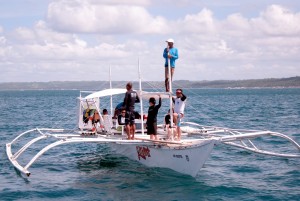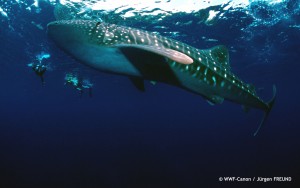With eagle-eyes, our boat spotter observes a massive silhouette approaching our banca.
“Jump. Now!” Our Butanding Interaction Officer (BIO) sounds a call for us to hurriedly hurl ourselves at the water, so we can swim with the gentle giants of the sea. Within seconds after we plunge into the water, a five-meter whale shark (Rhincodon typus) – easily recognizable by its unique shape, gaping mouth, plus dots and lines on its grey skin – comes into view. It is a sight to behold.
Donsol in the Philippine province of Sorsogon is a popular tourist destination for whale shark interaction. A town whose booming economy was fuelled by the butanding, Donsol has risen from a fifth-class to a first-class municipality since a community-based whale shark ecotourism program was established in 1998. The local government, in partnership with top environmental solutions provider World Wide Fund for Nature (WWF-Philippines) and tourism stakeholders, developed the program.
The whale shark we saw was just one of six individuals our group encountered. Researchers from WWF-Philippines and the Large Marine Vertebrates Project Philippines (LAMAVE) have recently recorded as many as ten individuals per day.
“The whale sharks are indeed back,” beams Elmer Quizon, a BIO for eight years. “Whenever we set out to sea, we always tell our visitors that sightings of marine wildlife like whale sharks are not guaranteed, precisely because they are wild. This season has been good to us. The number of whale shark interactions have been higher compared to the past two years.”
WWF-Philippines data validates this.
For March and April, 37 and 38 individuals were identified, respectively. “There have been interactions daily for the last two months,” beams WWF-Philippines Project Manager Raul Burce.
This data is celebrated for a reason.
Where Have the Whale Sharks Gone?
Whale sharks congregate in Donsol Bay because of the large concentrations of plankton which feed on the nutrients discharged by the town’s rivers. Whale sharks can usually be seen from December to May, with sightings peaking between February and May when plankton levels are highest.
Fifteen years ago, WWF-Philippines partnered with the local government plus other tourism stakeholders to develop a community-based whale shark ecotourism program and establish guidelines for whale shark interactions.
Over the last decade, the organization has also sustained a conservation and science program that identifies individual whale sharks by capturing images of their unique spot patterns. The photos are uploaded onto a global database for cataloguing. The program also covered the attachment of satellite and sonar tags on whale sharks to track their movements and migration patterns.
The ecotourism program has generated jobs for locals – many of which are now tour guides, Butanding Interaction Officers, boat crew members, captains, home-stay owners, resort staff and associated service providers.
Over the past two seasons, whale shark numbers plummeted. There were stretches when BIOs only saw one to two whale sharks per week. In 2013, the maximum number of whale shark sightings per day was just two, rising to four the following year.
“There was a time when we had a 90% to 95% interaction rate. When our boats returned to shore, visitors were ecstatic to share stories about their six or more whale shark sightings. The last two years were difficult – there were days without any sightings at all,” says Quizon.
Tourist arrivals echoed this slump. In 2013, there were 17,300 tourist visits recorded – a decline of 35% from the prior season. In 2014, the numbers slumped further to 13,000 – a 25% decline.
WWF-Philippines’ sonar arrays revealed the presence of whale sharks and plankton in the deeper portions of Donsol Bay, where water is colder. “Though climate change has no direct impact on whale sharks as it has on coral reefs and oceanic acidity levels, it alters sea temperatures which affect the food sources of apex predators like whale sharks,” adds Burce.
With ecotourism as the town’s primary lifeblood, Donsol aimed to improve revenue and revive slumping visitor arrivals by leveraging other activities like firefly watching plus tours to nearby isles like pristine Ticao Island.
After enjoying a steady stream of tourists for over two decades, Donsol learned to diversify its tourism menu and the value of not placing all its eggs in one basket.
Prime Example of Whale Shark Ecotourism
Now it is clear that the Gentle Giants are back. Donsol is ready to learn from the past two years’ hard lessons and rise again.
“There were 31 individuals identified in the 2014 season. We have already seen 23 in just one week in March 2015. The whale sharks are coming back,” says Emer McCoy, a LAMAVE researcher who volunteers for WWF-Philippines.
The maximum number of sightings per day stands at 10 individuals – a huge jump from the maximum of four the past season.
Burce attributes this to healthier ecosystems in Donsol Bay and nearby waters. “It appears that the seas are now more healthy and productive. Small-scale fishermen have reported an increase in their catch – an indicator of the reduction of fishing pressure.
Today, the Donsol Visitor Center is humming with activity. Local and foreign visitors pack the orientation room to listen to guidelines on proper whale shark interaction procedures. The hubbub provides high hopes that whale shark ecotourism will remain as a prime socioeconomic driver for the town, without luring the sea’s gentle giants with bait and daily rations of krill.
Anchored on the three principles of sustainable ecotourism – natural asset protection, direct community benefit, plus enhanced visitor experience – Donsol’s community-based whale shark ecotourism program stands as one of the best sustainable wildlife interaction offerings in Southeast Asia. (30)
Whale sharks on a comeback. Higher concentrations of plankton in Donsol Bay heralded the return of whale sharks. The town of Donsol is the famed Whale Shark Capital of the country. As many as 10 individual sharks have been identified in one day. (©Jürgen Freund / WWF-Canon)
 Economic engine driven by gentle giants. During the peak season, a maximum of 30 tourist boats are allowed to set out to sea for only three hours. Each boat – manned by a Butanding Interaction Officer (BIO), a spotter, and four crew members – is allowed to carry up to six tourists. (© David N. David / WWF-Philippines)
Economic engine driven by gentle giants. During the peak season, a maximum of 30 tourist boats are allowed to set out to sea for only three hours. Each boat – manned by a Butanding Interaction Officer (BIO), a spotter, and four crew members – is allowed to carry up to six tourists. (© David N. David / WWF-Philippines)
(Courtesy of World Wide Fund for Nature, Written by WWF Communications Officer Sophia Dedace)









